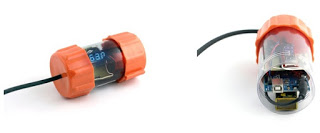 It may look like a pipebomb, but those little devices to the left could change how transportation planning is done. Transportation planning is all about data; we look at how many people are using the transportation system, where they’re going, how they’re getting to their destinations (bus, bike, personal vehicle, etc.), what time they travel, etc. Collecting and analyzing this data helps us determine patterns and make predictions for the future. For instance, if we know there are X many people using the current regional transportation system, and the population is expected to increase by X by 2040, we know we need to plan for X additional vehicles on the roads in the next few decades. This helps us analyze what it will take to bring our road to the point they can support this traffic, or plan for other transportation options such as additonal bus service or bike lanes and pedestrian trails.
It may look like a pipebomb, but those little devices to the left could change how transportation planning is done. Transportation planning is all about data; we look at how many people are using the transportation system, where they’re going, how they’re getting to their destinations (bus, bike, personal vehicle, etc.), what time they travel, etc. Collecting and analyzing this data helps us determine patterns and make predictions for the future. For instance, if we know there are X many people using the current regional transportation system, and the population is expected to increase by X by 2040, we know we need to plan for X additional vehicles on the roads in the next few decades. This helps us analyze what it will take to bring our road to the point they can support this traffic, or plan for other transportation options such as additonal bus service or bike lanes and pedestrian trails.
That’s all fine and good, but the reality of the situation is that gathering that data is time consuming and expensive. You either have to pay someone to do traffic (and sometimes bike and pedestrian) counts for you, or you have to buy spendy devices that do it, and usually the software to go with it, or a professional who downloads and crunches your numbers.
Or maybe you don’t anymore. A couple of New Yorkers, one a planner and one an engineer, came up with the ‘do it yourself’ traffic counter kits above called TrafficCOM that allows users to measure the volume, rate, and speed of traffic on any street, then upload the data for immediate sharing. The Atlantic Cities tells us how it works.

The CA PeTT Committee will be asked to recommend this device to the mayor's administration.
Really??? That is great!! I was thinking maybe partnerships; couple jurisdictions or agencies go in together to buy several and share them or something. They're fairly inexpensive and no one group is usually doing counts all the time, so they could go back and forth.
Excellent article. The image is look like one type of bomb but it consist of travelling information. Such a great article. It gathering all relevant information about traveling vehicles such as bus, car, bicycle, etc. This allows us evaluate what it will take to carry our street to the factor they can assist this traffic, or strategy for other transport choices such as additional bus services or bike paths and people trails. Marketing Research Companies